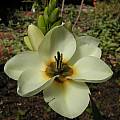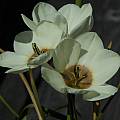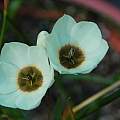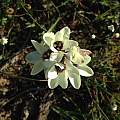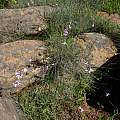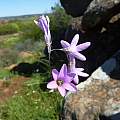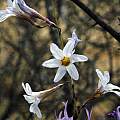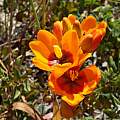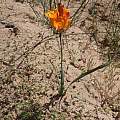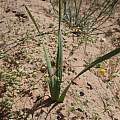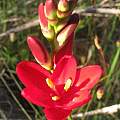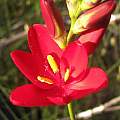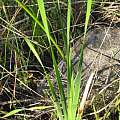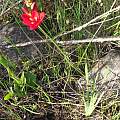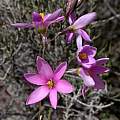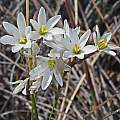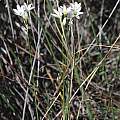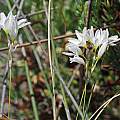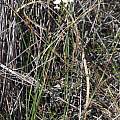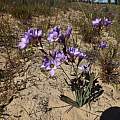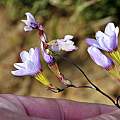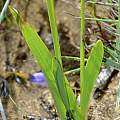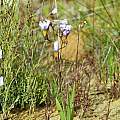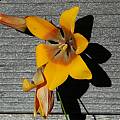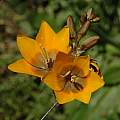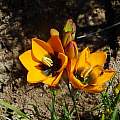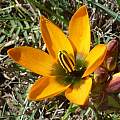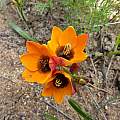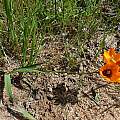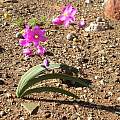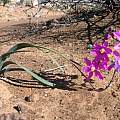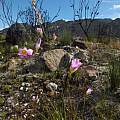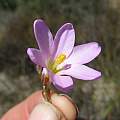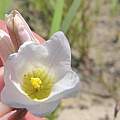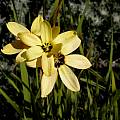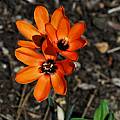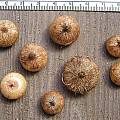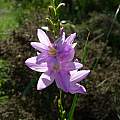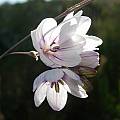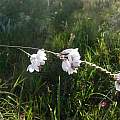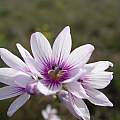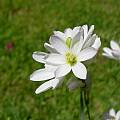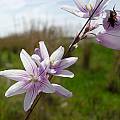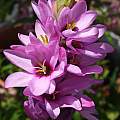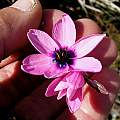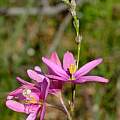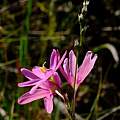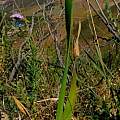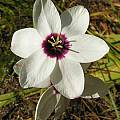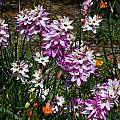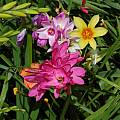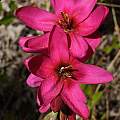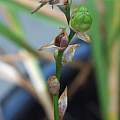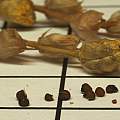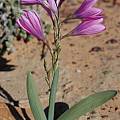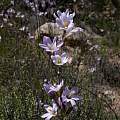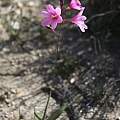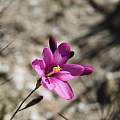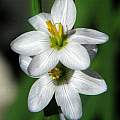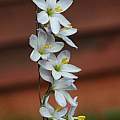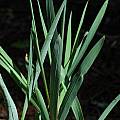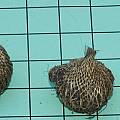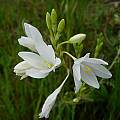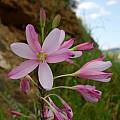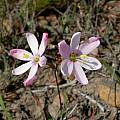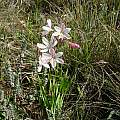Ixia is a genus in the Iridaceae family with 100 species mainly from the western, southwestern, and southern winter-rainfall areas of the Northern, Western and Eastern Cape Provinces of South Africa. Information and photographs illustrating Ixia a-c can be found on this page.
Ixia abbreviata Houtt., syn. Ixia lutea Eckl., syn. Ixia conferta var. ochroleuca, is a Western Cape species found on clay and granitic flats and slopes in renosterveld. Growing from 15-35 cm, it has sword-shaped leaves that are often twisted distally, and crowded white to pale yellow or red-purple flowers with dark centers. Bracts are usually rust-brown in the upper half. The first three photos by Bob Rutemoeller and Mary Sue Ittner. The last photo was taken at Elandsberg by Michael Mace of what he believes to be this species.
Ixia brunneobractea G.J.Lewis is endemic to the Bokkeveld Mountains where it grows in sandy soils in seep and marshes and flowers September to October. It grows from 25 to 45 cm and has white to cream colored flowers that are sometimes pink on the reverse of the outer tepals. It is distinguished by its glossy chestnut colored bracts that are sometimes torn at the apex. The first two photos were taken in the Nieuwoudtville Reserve by Cameron McMaster September 2011. The last two photos were taken near Nieuwoudtville by Mary Sue Ittner.
Ixia calendulacea Goldblatt & J.C.Manning, syn. Ixia maculata var. intermedia G.J.Lewis, is a northern and western Cape species where it grows in deep well drained sandy soils. Growing to 25 cm, this showy species with orange or orange-red flowers with a dark center is threatened by development in the areas where it grows. Flowers close to a degree when the temperature drops. The first photo was taken by Rachel Saunders. The other photos from iNaturalist were taken by Gregory Nicolson in October in the West Coast and shared under a CC BY-NC license.
Ixia campanulata Houtt. grows on damp sandstone slopes in the Western Cape and flowers October to November. Plants grow from 10 to 35 cm high with linear leaves and mostly deep red, sometimes white, flowers. Unfortunately, it is not widely available. Photos below from iNaturalist taken in October near the Upper Breede Valley by Douglas Euston-Brown and shared under a CC BY-SA license.
Ixia capillaris L.f. is widespread from the Western Cape to the Little Karoo and Riversdale where it grows on flats, hills, and mountain slopes in sandy or clay soils. Growing from 20 to 45 cm, this species has narrow leaves and white to mauve blue to pink flowers with a funnel-shaped tube. It flowers July to September (spring). The first photo from the book Plants of the Klein Karoo is courtesy of Jan and Anne Lise Schutte-Vlok who described it as occurring on the lower slopes of the inland mountains of the western Little Karoo in rocky places. The rest of the photos from iNaturalist were taken by Felix Riegel near Bredasdorp in October and shared under a CC BY-NC license.
Ixia contorta Goldblatt & J.C.Manning, syn. Ixia rapunculoides Delile var. rigida in sense of G.J.Lewis (excluding the type), is from the Western Cape Mountains (cold Bokkeveld north to the Cedarberg and east to Touws River) where it grows in well-drained, sandy soils. It is threatened by habitat loss. Growing from 10 to 30 cm (usually 15 cm or less), it has 3 falcate leaves with the lower two with thickened margins and midribs and the uppermost sheathing the stem. It has 2 to 6 blue purple unscented upright flowers with a yellow throat sometimes edged with a band of dark purple, included filaments, and a wiry twisted spike with twisted branches. It flowers in spring, mid September to October. The first photo is from Rod Saunders of Silverhill Seeds. The rest of the photos from iNaturalist were taken by Richard Adcock in the Cederberg in September and shared under a CC BY-NC license.
Ixia curta Andrews grows on sandy flats and slopes in the southwest Cape. This species flowers in spring. Flowers are orange with a brown center often outlined by a reddish center. It is similar to Ixia monadelpha but has bowl-shaped flowers and wider segments. The first two photos from Mary Sue Ittner and Bob Rutemoeller show a plant grown from seed. The last four photos were taken by Cameron McMaster near Darling September 2011.
Ixia curvata Baker grows on rocky slopes in the Northern Cape, Western Karoo, and the Roggeveld, flowering July-September. Leaves are rigid and linear and flowers are deep pink. Photos taken by Alan Horstmann; the last two were taken near Middelpos in September.
Ixia divaricata Goldblatt & J.C.Manning, syn. Ixia latifolia var. angustifolia G.J.Lewis, is found on seasonally wet, stony sandstone flats and rocky sites in the mountains of the southwestern Cape. Growing to 50 cm, it is distinctive from other genera once included in Ixia latifolia by its unusual branching pattern. The stiff, straight lateral branches are held at angles of 30 to 50° to the main axis and bear mostly 3-5 white to pale pink erect flowers crowded distally. Filaments are usually shortly exserted from the tube. Plants flower in spring. The first photo was taken by Rod Saunders of Silverhill Seeds. The other photos from iNaturalist were taken by Nick Helme in October and November in the Western Cape and shared under a license.
Ixia dubia Vent. is a species with orange or yellow flowers, often with dark centers, and is found on sandstone and granite flats and slopes in the Cape from Piketberg to Caldon. Photos by Mary Sue Ittner. The third picture taken by Roy Herold in the hills above Muizenburg, south of Cape Town, in October 2002 of this plant is probably this species.
The orange flowered version (syn. Ixia frederickii M.P.de Vos) was once considered to be a separate species found from only two localities in the Southwest Cape and blooming in October. Photos by Mary Sue Ittner. The last shows the corms.
Ixia flexuosa L. is found on clay flats and slopes from the Cape Peninsula to Riversdale and therefore is found in areas with winter rainfall and year round rainfall. It blooms winter to spring and has small pink, mauve, or white flowers, sometimes with deeper pink veins. Photos below were taken by Cameron McMaster in Caledon, Napier, Fairfield, and Stormsvei in the Overberg.
The first photo by Bob Rutemoeller is of one blooming April 2003 in Northern California. The second photo was taken by Michael Mace in California.
Ixia gloriosa G.J.Lewis is found on clay slopes in renosterveld in the Montagu district. It has deep pink flowers with a shining purple-black center. Stamens are erect and black. It grows to 60 cm and has narrow leaves and flowers in spring. The first photo from the book Plants of the Klein Karoo is courtesy of Jan and Anne Lise Schutte-Vlok. The second photo taken by Bob Rutemoeller in the Little Karoo September 2003 is what we think is this species since it matches the description and was found in the right place flowering at the right time.
Ixia helmei Goldblatt & J.C.Manning was described in 2016. It has an unusually long perianth tube (±12 mm long), two leaves, and a few-flowered spike. It flowers mid to late October and is pollinated by long tongued flies. Photos from iNaturalist were taken by Nick Helme in October and November in the Western Cape and shared under a CC BY-SA license.
Ixia hybrids. The first three photos are from Mary Sue Ittner. Hybrids planted in the ground have increased dramatically in her Northern California garden as they produce small cormlets around the corm. They make quite a show, but can be really floppy, especially if it rains when they are in bloom. The last photo is a named variety, Ixia 'Venus,' photographed by Michael Mace. It was obtained at the San Francisco Landscape Garden Show in the 1990s, and was labeled as a selection of Ixia paniculata, but that is hard to believe. It's probably a hybrid. It's easy to grow in California and persists when grown in the ground but doesn't seem to spread. The flowers are vibrant magenta, even brighter than the photo can show.
Photographs by David Pilling: the first one shows one viable seed pod ripening, the second shows a dried seed pod and seed on a 10 m grid, and the third is of a corm growing.
Ixia latifolia D.Delaroche, section Morphixia, is a species of clay, clay loam and sandy soils in renosterveld or dry fynbos from the southwestern part of the Western Cape east to the Karoo and the Swartberg. It has relatively large, pink to mauve, rarely white, flowers with a relatively well-developed perianth tube and spreading tepals with exserted stamens and bracts with narrowly acute teeth. The two basal leaves are usually fairly broad and the third leaf sheathes the stem. In his description of this species in 1962 Lewis recognized five varieties. In 2011 Goldblatt and Manning in the paper Systematics of the southern African genus Ixia (Iridaceae) elevated three of them as four separate species: small flowered var. parviflora G.J.Lewis to Ixia parva, var ramulosa G.J.Lewis, plants with several, short lateral branches bearing one or two, rarely three, flowers from Namaqualand to Ixia ramulosa and var. angustifolia G.J.Lewis to Ixia divaricata with straight long branches and flowers crowded distally and the other, a high elevation species to Ixia monticola Goldblatt & J.C.Manning distinguished by soft-textured leaves and dry membranous, brown, onion-skin-like corm tunics. The photos below could be this species as currently described or as described in the past. The first photo from Rod Saunders from Silverhill Seeds and the second from the book Plants of the Klein Karoo courtesy of Jan and Anne Lise Schutte-Vlok. The last two photos were taken by Alan Horstmann in October near Ceres.
Photos below were taken by Mary Sue Ittner of plants grown from seed supposed to be this species and illustrate the flowers, leaves, and corms on a 1 cm grid.
Ixia longituba N.E.Br. grows on hills, flats and shale slopes from Caledon to Swellendam and flowers late September to November. It has cream colored to pink flowers sometimes flushed pink on the outside. Photos were taken at Caledon and Napier in the Overberg by Cameron McMaster.
